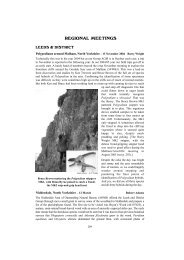Full Contents as pdf File - Natural History Museum
Full Contents as pdf File - Natural History Museum
Full Contents as pdf File - Natural History Museum
You also want an ePaper? Increase the reach of your titles
YUMPU automatically turns print PDFs into web optimized ePapers that Google loves.
not found although the gametophytes were identified once more, Ken Trewren being an<br />
expert in this arcane art. A polypody on an oak tree w<strong>as</strong> thought to be P. cambricum and<br />
this w<strong>as</strong> subsequently verified.<br />
Some of us wearily headed for home via Kate Kearney’s Cottage, a hostelry supplying tea and<br />
scones, whilst the more hardy fern hunters went on to try and find pillwort. Again no success,<br />
<strong>as</strong> they failed to penetrate the conifer plantations and Rhododendron thickets to get down to<br />
the lake, though they did find greater butterwort (Pinguicula grandiflora), New Zealand<br />
willowherb (Epilobium pedunculare var. brunnescens) and sundew (Drosera rotundifolia).<br />
We were again invited back to White Sands for a delicious supper cooked by Gill and<br />
Karen and afterwards a special treat – a visit to the lakeside to see the Natterjack toads,<br />
which were croaking love songs by the lakeside among the Equisetum fluviatile.<br />
Ross Island and Torc Waterfall (Wednesday) Sam Thom<strong>as</strong> & Alan Ogden<br />
Ross Island in Killarney National Park w<strong>as</strong> our first destination. Leaving the cars in the<br />
visitors’ car park (00/950888) we walked to the c<strong>as</strong>tle, seeing plants of Asplenium<br />
scolopendrium, A. ruta-muraria, A. trichomanes subsp. quadrivalens and Polypodium<br />
cambricum on the walls. We then walked through delightful woodland towards Library<br />
Point on the opposite side of the lough to where we had been the previous day.<br />
We p<strong>as</strong>sed a small area of willow and alder carr where we found Dryopteris carthusiana,<br />
D. dilatata, Athyrium filix-femina and Equisetum arvense. The woods were rich in ferns and we<br />
soon recorded Pteridium aquilinum, Dryopteris affinis subspp. affinis and borreri, D. filix-m<strong>as</strong>,<br />
Polystichum setiferum and more Asplenium scolopendrium. Ken thought he found<br />
D. x complexa, but a subsequent chromosome count put it in the borreri group (triploid). A<br />
ruined cottage revealed no new ferns, though it w<strong>as</strong> roofed by a large tree in an extraordinary<br />
balancing act. We p<strong>as</strong>sed luxuriant specimens of Osmunda regalis (called Emperor fern by the<br />
Irish), Polypodium vulgare, Blechnum spicant, Equisetum arvense, E. fluviatile and<br />
E. x litorale before coming to the object of our walk: Thelypteris palustris. This w<strong>as</strong> growing<br />
in a boggy area with Osmunda regalis. Polypodium interjectum w<strong>as</strong> seen growing on many<br />
horizontal mossy branches. Other plants were noted, including a number of species of orchids:<br />
early purple, common spotted, common twayblade, bird’s-nest orchids and a helleborine.<br />
93<br />
photo: A.M. Paul<br />
Discussing Dryopteris affinis on Ross Island<br />
Sam Thom<strong>as</strong>, Pat Acock, Paul Ripley, Steve Munyard & Ken Trewren

















